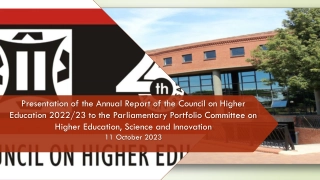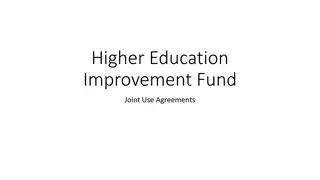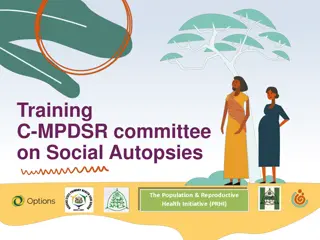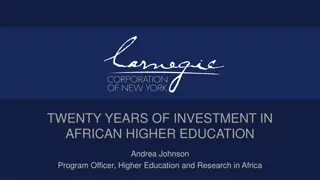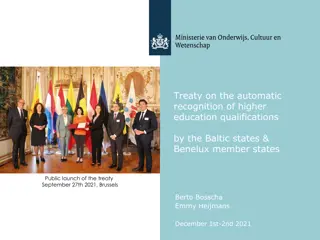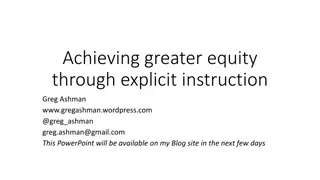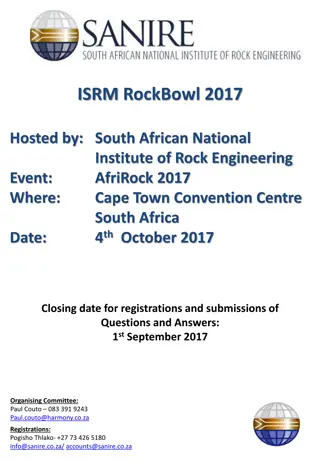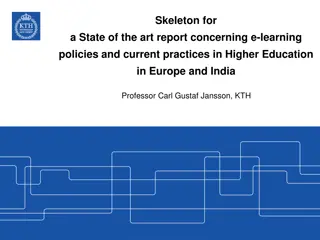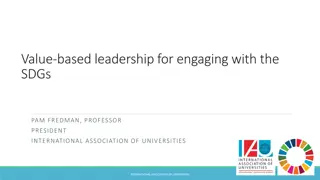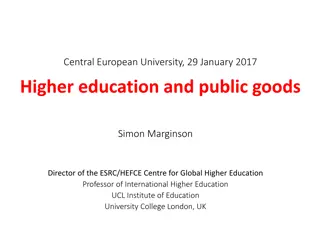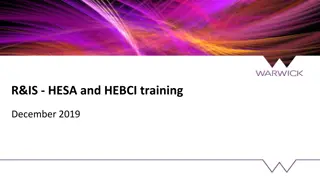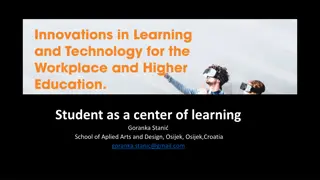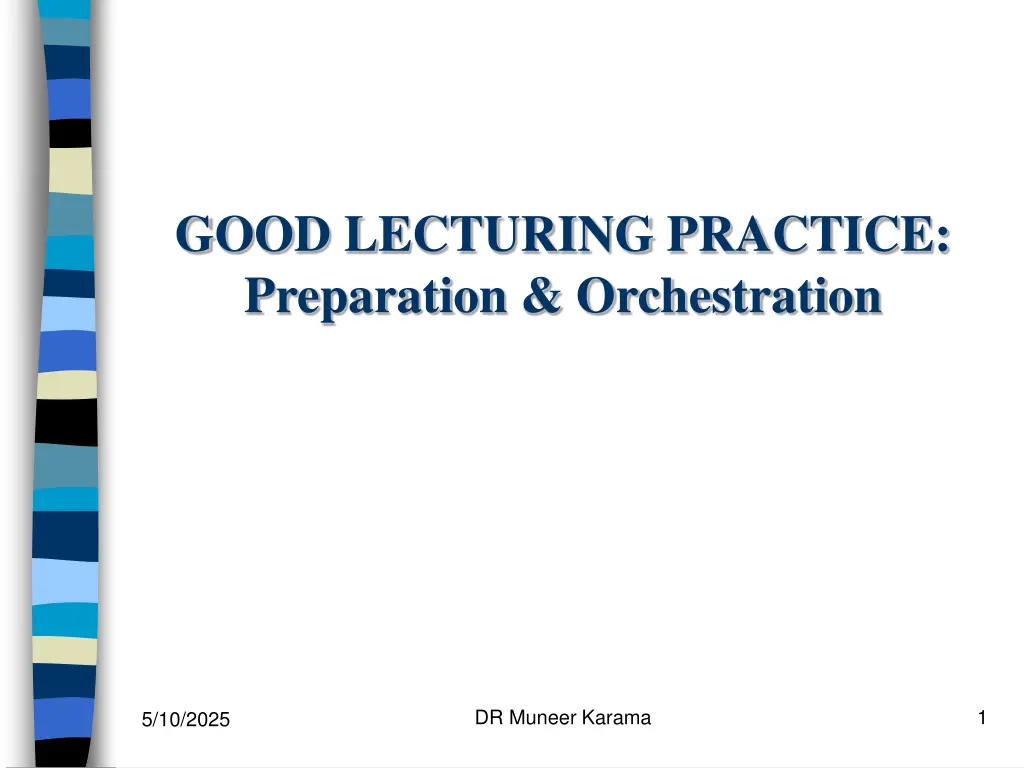
Effective Lecture Preparation and Orchestration Tips for Educators
Discover strategies for effective lecture preparation and orchestration with Dr. Muneer Karama. Learn about aligning course components, setting learning goals, drafting objectives, and more. Enhance your teaching skills and engage students in meaningful learning experiences.
Download Presentation

Please find below an Image/Link to download the presentation.
The content on the website is provided AS IS for your information and personal use only. It may not be sold, licensed, or shared on other websites without obtaining consent from the author. If you encounter any issues during the download, it is possible that the publisher has removed the file from their server.
You are allowed to download the files provided on this website for personal or commercial use, subject to the condition that they are used lawfully. All files are the property of their respective owners.
The content on the website is provided AS IS for your information and personal use only. It may not be sold, licensed, or shared on other websites without obtaining consent from the author.
E N D
Presentation Transcript
GOOD LECTURING PRACTICE: Preparation & Orchestration DR Muneer Karama 1 5/10/2025
Alignment components in your course (content, structure, teaching methods, assignments, assessment) are aligned to the intended outcomes backward design . DR Muneer Karama 2 5/10/2025
Alignment Video DR Muneer Karama 3 5/10/2025
DR Muneer Karama 4 5/10/2025
GOOD LECTURING PRACTICE: Preparation & Orchestration The best general advice to the teacher who would lecture well is still, 'Don't lecture. Eble (1988) Good teaching employs head, hands and heart. K. P. Kwan (1996) Most student learning occurs outside the classroom. McKeachie (1994) DR Muneer Karama 5 5/10/2025
SESSION OBJECTIVES By the end of this session you will have: Discussed key issues and concerns about lecturing Generated solutions addressing these key issues Explored the components of good lecturing practice 5/10/2025 More specifically: Deciding on learning goals Organizing the lecture Preparing lecture materials Practicing the lecture presentation Delivery skills Learning from your own lecturing DR Muneer Karama 6
I. DECIDING ON LEARNING GOALS Here are four steps to help you decide what and how much to include in your lecture: Select the Main Points Draft Learning Objectives Prioritize Revise and Complete Outline DR Muneer Karama 7 5/10/2025
DECIDING ON LEARNING GOALS 1. Select the Main Points i. Write a one sentence purpose statement for your lecture ii. List the main points you plan to cover iii. Generally no more than five major topics iv. Points can be: topical heuristically (reasons why) chronological procedural DR Muneer Karama 8 5/10/2025
DECIDING ON LEARNING GOALS 2. Draft Learning Objectives i. Turn your purpose and main points into objectives of what the students should learn ii. List everything you want students to learn iii. Include examples, activities, and demonstrations that would help them learn each main point DR Muneer Karama 9 5/10/2025
DECIDING ON LEARNING GOALS 3. Prioritize i. Go through your outline and prioritize: 1 = essential for students 2 = important but not essential 3 = nice to know ii. Think in terms of what you want students to learn rather than what you will present DR Muneer Karama 10 5/10/2025
DECIDING ON LEARNING GOALS 4. Revise and Complete Outline i. Make sure you have examples, demonstrations, questions and practice activities for each main point Be sure to include your introduction, and conclusion iii. Assign times for each main point and activity iv. Continue revising your outline until you have your best guess as to the amount of information and activities you can cover In the time available v. Final outline becomes a blueprint for developing the lecture ii. DR Muneer Karama 11 5/10/2025
II. ORGANIZING THE LECTURE Lectures have three distinct parts: Introduction: What you're going to learn Body: Learn it Conclusion: What you've learned DR Muneer Karama 12 5/10/2025
ORGANIZING THE LECTURE Introduction 1. Purpose to gain your students attention ( Attention Getter ) to state your purpose and main points ( Objectives ) to relate to students' motives ( Motivation ) to orient your students to the organized main ideas of the lesson ( Advance Organizer ) to the time schedule and techniques of presentation ( Agenda ) to help your students recall related information ( Review ) 5/10/2025 DR Muneer Karama 13
ORGANIZING THE LECTURE Introduction 2. Gaining attention describe an interesting case use a quotation statistics unusual story current events humor DR Muneer Karama 14 5/10/2025
ORGANIZING THE LECTURE Introduction 3. Stating your purpose and main points state overall purpose of lecture state main points to be covered briefly explain each point explain how topic will affect them DR Muneer Karama 15 5/10/2025
ORGANIZING THE LECTURE Body 1. Begin by restating each main point/learning goal 2. Explain and demonstrate main points present essential points first, followed by most important next, and nice to know last 3. Use examples to facilitate understanding at least one example per idea verbal and/or visual use several examples for complex ideas use interesting examples restate idea at end of example(s) make sure students can relate to examples 5/10/2025 DR Muneer Karama 16
ORGANIZING THE LECTURE Body 4. Have students practice using main points provide problems, cases, questions, etc., where students respond students respond by writing answers in pairs or small groups students responses indicate their understanding of the main points provide correct answers to practice and explain why it is correct ( Feedback & Remediation ) 5. Briefly summarize at end of each main point 6. Provide transition statement to next main point DR Muneer Karama 17 5/10/2025
ORGANIZING THE LECTURE Conclusion 1. Provides a logical ending a sense of completeness and structure. 2. Restate main points ( Summary ) 3. Restate purpose sentence and how topic relates to audience ( Objectives" & "Motivation ) 4. Connect with other instructional segments of past and future ( Integration ) DR Muneer Karama 18 5/10/2025
ORGANIZING THE LECTURE Conclusion 5. Check to see whether students have accomplished the main purpose of the lecture (Checking can be done by teacher, peer, self) ( Test ) 6. Finish with a flourish on time enthusiastic use an attention getter DR Muneer Karama 19 5/10/2025
III. PREPARING LECTURE MATERIALS Your Lecture Notes Visual Aids Students Materials DR Muneer Karama 20 5/10/2025
PREPARING LECTURE MATERIALS Your Lecture Notes Notes should contain the sequence of what you will say and what students will be doing Notes should serve as reminders only Detailed notes on attention getters, transitions, conclusion Reminders for main/sub points Cues for examples and visual aids Reminders about presentation style DR Muneer Karama 21 5/10/2025
PREPARING LECTURE MATERIALS Your Lecture Notes Tips: Fewer the better/KISS (Keep it simple stupid) Develop your own style Numbered pages/sheets Print large Use only one side Try computer presentation software DR Muneer Karama 22 5/10/2025
PREPARING LECTURE MATERIALS Visual Aids What visual aids should include: An attention getter/a presentation overview Your main points Graphs, charts, graphics to support main points Directions for activities A closing attention getter DR Muneer Karama 23 5/10/2025
PREPARING LECTURE MATERIALS Visual Aids Tips: The Rule of 7 s - Overheads and slides should be limited to: 7 words per line 7 lines per visual aid 18 - 24 point font size Stories & Cartoons: Good idea, but what's the point? Graphs, charts and tables from books. Blow them up! DR Muneer Karama 24 5/10/2025
PREPARING LECTURE MATERIALS Students Materials Provide (some) materials that students can use for preparation before lecture (pre- readings, etc.) Provide handouts at the start of lecture so that students can: listen & think about what you are saying rather than just write add their own notes to yours DR Muneer Karama 25 5/10/2025
PREPARING LECTURE MATERIALS Students Materials Handouts should include: complex charts, tables, diagrams essential information (main points, key vocabulary, etc.) information for which accuracy is important (formulae, names, dates) DR Muneer Karama 26 5/10/2025
PREPARING LECTURE MATERIALS Students Materials Tips: consider interactive handouts in which students fill in some missing information during the lecture ascribe to the "less is more" principle DR Muneer Karama 27 5/10/2025
IV. PRACTICING THE LECTURE PRESENTATION There are five steps to practicing the lecture for delivery: Review Your Notes Early Practice Polishing the Delivery Formal Practice Mental Imaging DR Muneer Karama 28 5/10/2025
PRACTICING THE LECTURE PRESENTATION 1. Review Your Notes Work one section at a time Review until you can recall both the meaning of your notes and the sequence of thoughts Continue for entire presentation All mental nothing out loud DR Muneer Karama 29 5/10/2025
PRACTICING THE LECTURE PRESENTATION 2. Early Practice Begin practicing out loud Go one section at a time Work especially on introduction, transitions and conclusion DR Muneer Karama 30 5/10/2025
PRACTICING THE LECTURE PRESENTATION 3. Polishing the Delivery Practice out loud with visuals Pay attention to eye contact, gestures and delivery Time yourself DR Muneer Karama 31 5/10/2025
PRACTICING THE LECTURE PRESENTATION 4. Formal Practice Go through entire presentation Invite colleagues, staff, etc. to listen Audiotape/videotape your own lecture DR Muneer Karama 32 5/10/2025
PRACTICING THE LECTURE PRESENTATION 5. Mental Imaging Mentally practice See yourself in front of the audience Give yourself a pep talk DR Muneer Karama 33 5/10/2025
PRACTICING THE LECTURE PRESENTATION Final Thoughts on Preparing to Present... Prepare ahead of time Practicing aloud does make a difference Identify and develop your own style DR Muneer Karama 34 5/10/2025
https://flexiblelearning.auckland.ac. nz/teaching-large-classes/1.html DR Muneer Karama 35 5/10/2025
V. DELIVERY SKILLS Prepare the Environment Before Lecture Verbal Delivery Nonverbal Delivery Click here for the checklist to guide you in delivering your lecture (To read the file in PDF format, Acrobat Reader is required.) DR Muneer Karama 36 5/10/2025
VI. LEARNING FROM YOUR OWN LECTURING Self Reflection Feedback from Colleagues and Other Expects Feedback from Students DR Muneer Karama 37 5/10/2025
LEARNING FROM YOUR OWN LECTURING Self Reflection Reflect upon what went well and what needs modification or change Jot ideas directly on your lecture notes so you will be reminded of revisions for next time. Video or audiotape a lecture for private review (microteaching) DR Muneer Karama 38 5/10/2025
LEARNING FROM YOUR OWN LECTURING Colleagues and Other Experts Sit in a colleague s lecture, or ask someone to sit in your lecture Read about teaching in general and/or teaching your subject area Make use of local educational consultants either for workshops, or individual consulting DR Muneer Karama 39 5/10/2025
LEARNING FROM YOUR OWN LECTURING Students Collect feedback from students Types of feedback: informal conversations (reliable?) one minute papers (to check students understanding) formative surveys (What is helping students learn? What could you do to make their learning easier?) DR Muneer Karama 40 5/10/2025
GOOD LECTURING PRACTICE: Preparation & Orchestration A session in Preparing to Teach: Introductory Programme for New Teachers Enjoy Lecturing! DR Muneer Karama 41 5/10/2025

